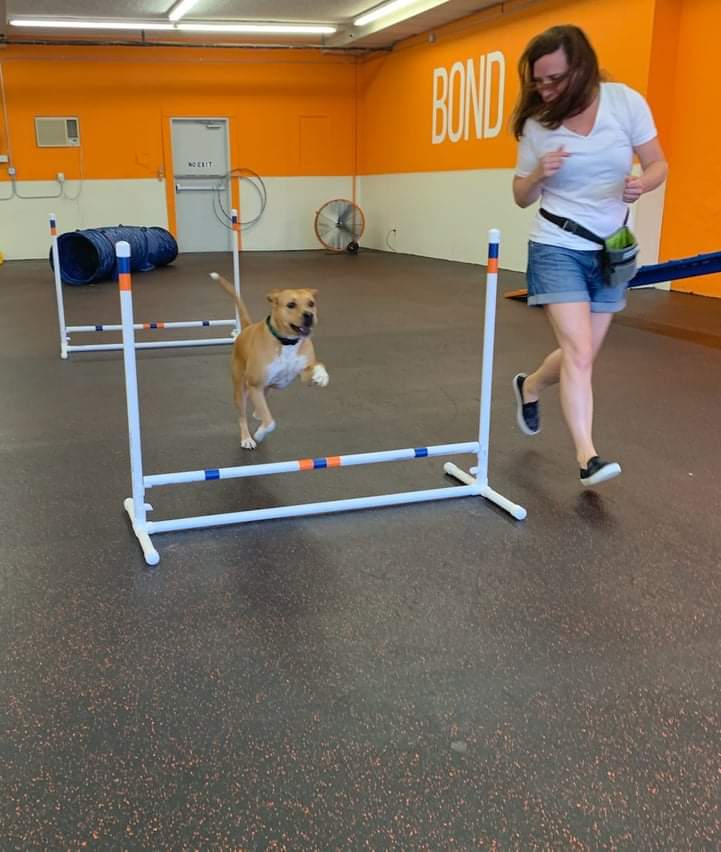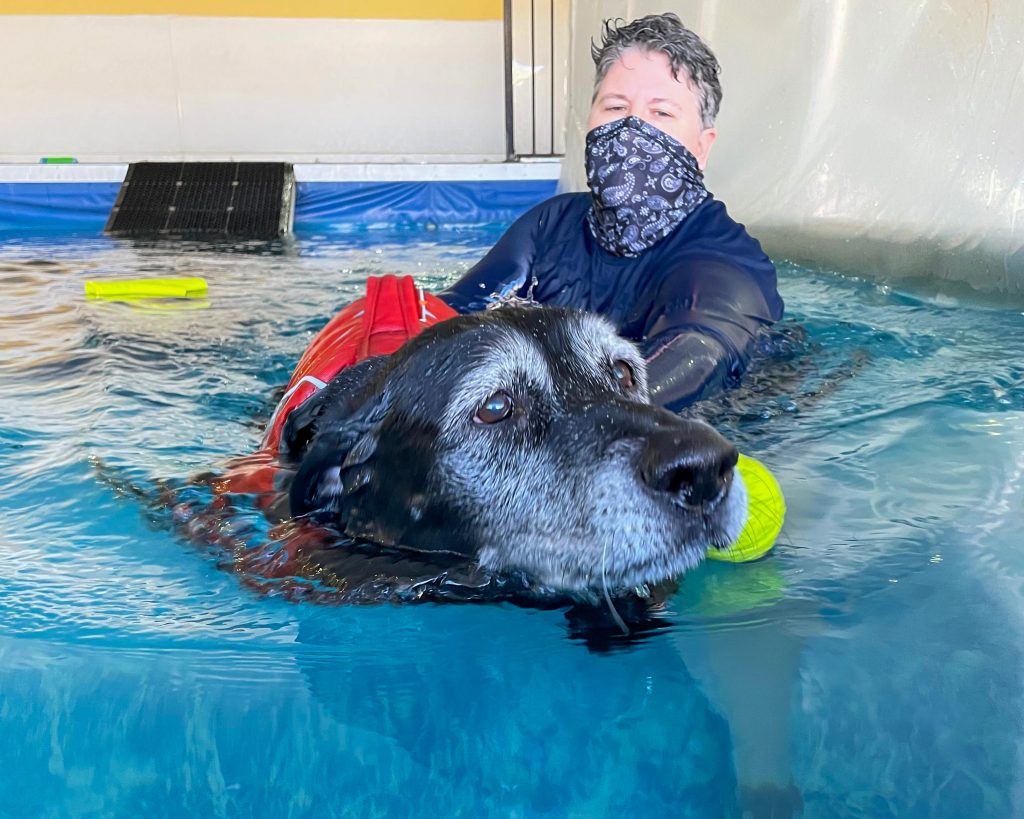At 118 pounds, Thor, a Cane Corso, is the size of a small adult human. His foreboding size, along with his docked ears, make him a bit intimidating in public, says his owner Morgan Grinley, a surgical veterinary technician and groomer from Ohio.
Thor isn’t aggressive—Grinley describes him as a “ginormous chicken”—but she knows that his breed tends to be protective, and to other dogs and people, he can be seen as threatening.
So, Grinley started working with Thor from an early age, seeking out ways to socialize him, build his comfort and confidence in public, and keep him active. This led Thor and Grinley on many adventures: hiking, barn hunts, dock diving, and, most recently, dog gyms.
At one facility, Thor completed obedience training. More recently, at Pinnacle Dog Sports in Cleveland, Ohio, Thor ran, crawled, and jumped his way through a canine agility course.
When Grinley praised Thor for completing the course, “he was so excited with himself,” she said.
For a big dog like Thor, a dog gym is a safe and controlled environment to play and exercise as well as build skills in obedience and agility—and it sure beats a walk in the cold, Ohio winter.

Thor during a brief moment of rest at Pinnacle Dog Sports. Courtesy of Morgan Grinley
Gyms for Dogs: A Growing Trend for Fitness and Fun
Historically, the options for dog exercise are what you might think, with the good old fashioned walk topping the list, along with other activities, like play at dog parks, hikes, and runs.
Dog gyms, aka canine fitness centers, are a growing alternative for dogs to stay active, and they’re popping up for a lot of reasons. They’re great for dogs like Thor, who need exercise but may be intimidating to other dogs at the dog park, or on a walk. Memberships usually offer access to a dedicated facility with specialized equipment, the support of specialists and trainers, and a variety of fitness, sport, and mobility activities.
Many gyms offer agility courses and training classes. Those classes might include everything from basic obedience to tricks to advanced agility, preparing dogs and their humans for competition. Some dog gyms also have swimming pools or amenities that target dogs’ specific exercise needs.
For regions with particularly hot summers or very cold winters, a climate-controlled dog gym is a great way to give dogs the activity they crave.
Perhaps most importantly, every dog gym promises a fun bonding experience for a dog and their parent. All this ensures that all dogs—and their humans, too—have a safe place to run and learn, no matter their size, skill level, or abilities.
Dog gyms—which usually fall somewhere in between an indoor dog park and a traditional dog training facility—do require memberships. Of the three mentioned in this article, rates range from $35 for a drop-in session to nearly $200 for an all-inclusive monthly membership. But for many dog parents, the perks of a structured, safe, and controlled indoor environment for their pets to play is worth it.
Structured Play to Challenge the Body and Mind
At The Dog Gym in Houston, Texas, owner Molly Taylor requires that every new client take a beginners’ agility course. Like many dog gyms, her space is stocked with equipment that could lead to injury for dogs and owners without the right training and supervision.
Taylor is a veteran of the pet care industry; she has owned Molly’s Mutthouse, a doggy daycare, boarding, and grooming center in Houston, for seventeen years. When the pandemic hit and pet owners suddenly spent more time at home, daycare and boarding needs dried up. She converted 3,000 square feet of the existing space from a daycare to an agility fitness center and opened The Dog Gym earlier this year.
“In Houston, we have the heat, the humidity, the rain,” she said. “There’s not a lot to do outdoors with your dog.”
The Dog Gym offers an year-round space for pet parents to get active with their pets. She explained that these facilities stand out from walks or visits to the park because they stimulate the mind along with the body.
“You get dogs working and using their brains, that wears them out quicker than a walk or a jog,” said Taylor. She told me she has seen some dogs’ behavioral issues all but disappear when they started visiting regularly.

A dog runs through an agility course at The Dog Gym in Houston. Courtesy of Molly Taylor, The Dog Gym
Safety is vital at the gym; only one dog can be off-leash on the agility course at a time, though other dogs and their owners can watch while they wait their turn. There’s one treadmill in the facility, with more to come. A weight scale was also recently installed, as local veterinarians have started referring overweight patients to the the gym.
Dogs might not be the only ones to see that scale move. The Dog Gym’s website jokes that dog parents won’t need their own gym memberships when they start bringing their pets regularly. Taylor assures me that running your dog through an agility course is as much a workout for the human as it is for the dog.
Like many gyms, The Dog Gym hosts classes like basic obedience, agility, trick-training, and rally, an obedience-based competition. Expert trainers staff every class, ensuring that dogs and their parents get the best possible instruction. In many ways, this makes The Dog Gym similar to a traditional dog training facility; what sets it apart is the emphasis on fitness and sport over obedience and competition.
Beginners’ agility, having fun, and keeping things low-key is the focus for Taylor. “It’s just people having fun,” she said, laughing. “If you get competitive, we’re referring you out.”
A Different Kind of Gym: Keeping Dogs Moving for Life
Kate Titus is a canine mobility specialist, a kind of physical therapist for dogs. She is uniquely qualified—and passionate about—the job. She’s a Certified Canine Fitness Trainer, a FitPAWS Master Trainer, and a Certified Canine Therapeutic and Sports Massage Therapist, as well as the author of two books on dog mobility.
“Mobility is life for dogs,” she says.
At A Loyal Companion, the canine fitness facility she owns and operates in Tucson, Arizona, where I live, she offers mobility evaluations, consultations, and equipment fittings for dogs who have trouble getting around.
I first met Titus this fall after noticing that our ten-year-old Labrador Retriever, Logan, was getting wobblier on his back legs. Several years ago, Logan had a fibrocartilaginous embolism, also known as an FCE or a spinal stroke. He quickly recovered the full use of his back legs but developed arthritis soon after.
I knew that swimming—especially for a water breed like a Labrador—was a great way to keep a dog in shape without the hard impact of walking or running. Water is hard to come by in the desert, but A Loyal Companion has both a fitness center and an indoor pool. I called and set up an appointment to have Logan evaluated.
During our first visit, Titus watched how Logan moved. She ran her hands along his back and legs, feeling for muscle mass and tone. She asked how often we took him out walking.
“Not often,” I admitted. Living in a hot climate, we were never consistent with walks to begin with. When Logan started struggling to keep up, they became even more infrequent. More often, we played fetch, his favorite game, in the long hallway of our house.
Unfortunately, fetch is one of the worst activities we can do with our dogs, Titus said. Hard sprints, sudden stops, twists and turns, and repetition are hard on the body. For Logan, she instead recommended “surf and turf:” strength and agility workouts and a few sessions in A Loyal Companion’s pool.
Agility means something different in this space than it does at the gyms in Ohio and Texas. The obstacles are minimal and tackled slowly. Every successful movement is celebrated, no matter how small, with an emphasis on balance and strength-building.
Titus’ goal—and now, mine too—is simple: keep Logan, and other dogs like him, moving.

Logan in the pool with Kate at A Loyal Companion. Photo by Carolyn Rousch
A Bonus Benefit of Dog Gyms: Bonding
On my third visit to A Loyal Companion, Logan and I hit the gym. For several minutes, Titus wove him between cones and over elevated rods. She had him sit and then stand, encouraging him to push up with his back legs, building both strength and confidence in his abilities.
Then it was my turn.
Titus led us both back through the exercises, offering gentle corrections as I guided Logan. When we left, she had already texted me a link to all of the activities we’d learned, telling me to work on them every day.
When it comes to mobility issues, owner participation is essential. Even after the workout at the gym is complete, dogs and their humans have to work together at home on their exercises—just like humans need to with physical therapy. The benefits of this are two-fold, however: dogs get regular, focused exercise to stay active or build their strength, and it’s an opportunity to build trust and connection between dogs and their humans.
Whether it’s at the gym or at home, any time spent training, exercising with, or playing with your dog is an opportunity to strength your connection together and bond.
Taylor talked about the magic that happens when dogs and owners work together, capturing the purpose of what the best dog gyms aspire to do: Help their clients and their dogs live longer, happier, healthier lives, together.
“The first time the dog does the agility course, the dog is smiling, the parents are smiling, and they’re just like, ‘Oh my God, I didn’t know he could do that!’” Taylor said. “And I was like, well, let’s keep going. I bet he can do more.”

3 Comments